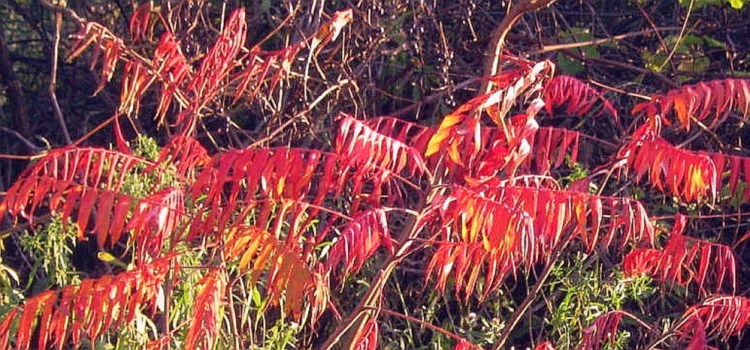Early October. Cool sunlight, breeze, full-scale beautiful fall day.
There’s a certain slant of light on autumn afternoons like this that cascades in from the sky and down across the stalks of dead goldenrod and horseweed and among the trees, and practically sets everything on fire. Sumac like tropical flames. The towering maple beside the driveway — red. Birch, poplar and ash trees — yellow. Oaks and beeches — preparing orange and copper. That purple conflagration we call burning bush.
A recent theory — sprung from the assumption among biologists that evolution is characterized by practicality — suggests that some plants make red leaf pigment in the fall as a protective measure. A study found that plants with red leaves otherwise have less resistance to damage from bright sunlight than plants with drabber fall colors. Red pigments, plant physiologist Bill Hoch reported, may act like sunscreen to curb damage that sunlight can do to drying leaves when the tree has begun redirecting nutrients to its roots for the winter.
Leaves are green in summer because they’re flush with chlorophyll, a pigment that soaks up light the tree photosynthesizes into energy. (To a tree, light is food.) Chlorophyll absorbs red and blue light, and reflects back green light, so the leaves look green. Being a somewhat unstable compound, chlorophyll has to be manufactured continuously all summer. To do this, the tree needs a lot of light and warmth. As the sun slowly lowers in the sky toward the end of summer, its light strikes the leaves at less direct angles, the air cools, and it’s harder for the tree to maintain its chlorophyll levels.
Meanwhile, the leaves contain other pigments as well. Carotene absorbs blue and blue-green light and reflects back yellow light, and anthocyanins absorb blue, blue-green and green light, and reflect back red. As the chlorophyll levels diminish, the carotene and anthocyanin levels stay the same or even increase, and so less green light, and more yellow and red light is reflected from the leaves. They turn red, yellow, orange, copper and purple according to the measures of carotene and anthocyanins in them. A red maple has a lot of carotene and its leaves turn scarlet. A sugar maple has more anthocyanin and its leaves go red and orange.
Because of the dwindling sunlight and the colder air, the deciduous trees gradually shut down their energy-making processes, and part of that shutdown includes shedding leaves. As the sunlight declines day by day, the production of growth hormones slows, and the leaves begin to age and die, a process called senescence. A layer of dead cells builds up between the leaf stem and the twig. Eventually that l ayer becomes brittle and breaks, and the leaf falls.
The recent study found that plants with red pigments were less damaged by autumn sunlight than were the drabber-leaved ones which do not use leaf nutrients as effectively. Some other studies are trying to determine whether red leaves don’t also somehow deter marauding insects.
Very practical, nature is. From this point of view, anyway. I wonder why the birches, poplars and ashes don’t make red leaves too, instead of their other bright-light protective tactics.
Cool sunlight, slanting down through the woods, throwing pools of saffron light in the firs and pines, and radiating inside explosions of milkweed fuzz, dry reed grass and dusky asters, detonates brain activity that appears, for biological purposes, completely useless. And yet, no matter what the leaf chemistry is, those colors set the day on fire.
There are more things in heaven and earth than are dreamt of in evolutionary science. And when October comes you can see them in the woods, like the distance on the look of life. The landscape listens, and combusts.
Dana Wilde lives in Troy. His writings on Maine’s natural world are collected in “The Other End of the Driveway,” available from online booksellers or by contacting the author at naturalist@dwildepress.net. Backyard Naturalist appears the second and fourth Thursdays each month.
Send questions/comments to the editors.



